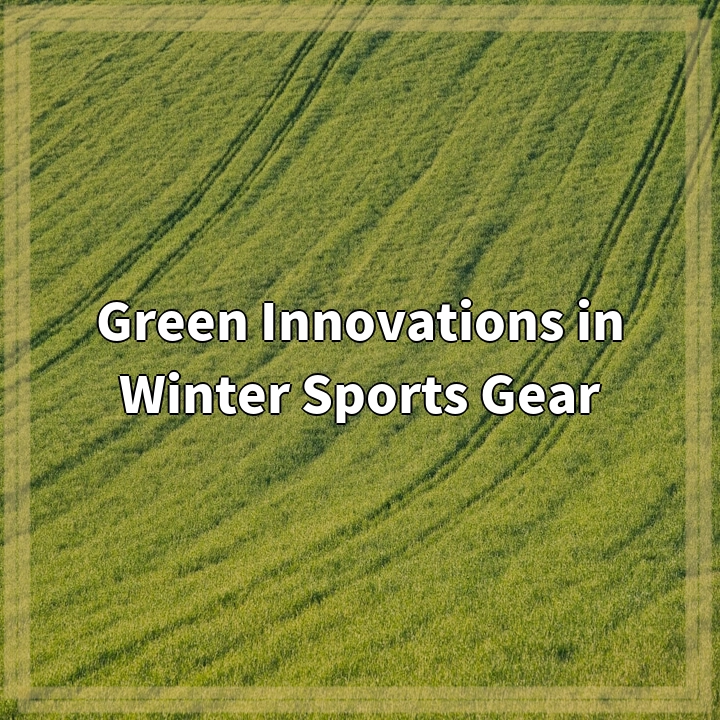
What it is:
In recent years, there has been a growing push towards developing green innovations in winter sports gear. This refers to the development and use of eco-friendly materials, manufacturing processes, and design concepts in the production of equipment and apparel for skiing, snowboarding, and other winter sports. Green innovations aim to reduce the environmental impact of winter sports activities and promote sustainability within the industry.
Real-World Problems:
The winter sports industry is not without its environmental challenges. Here are some of the key real-world problems associated with traditional winter sports gear:
1. Carbon Footprint: The production and transportation of winter sports gear releases significant amounts of carbon emissions into the atmosphere. This contributes to climate change and impacts the delicate ecosystems found in mountain regions.
2. Toxic Materials: Many conventional winter sports gear, such as ski bindings and snowboard coatings, contain toxic materials like polyvinyl chloride (PVC) and per- and polyfluoroalkyl substances (PFAS). These materials can persist in the environment, pollute water sources, and harm wildlife.
3. Waste Generation: Winter sports gear is often discarded and replaced regularly, leading to significant waste generation. Many of these materials are not easily recyclable or biodegradable, further exacerbating the environmental impact.
4. Resource Intensity: The production of winter sports gear requires the extraction and processing of finite resources, such as oil and metals. This places a strain on natural resources and can contribute to habitat destruction and ecosystem degradation.
5. Water Usage: The production of winter sports gear involves substantial water usage throughout the manufacturing process. This can lead to water scarcity in areas where water resources are already stressed.
6. End-of-Life Management: Disposal of old or damaged winter sports gear poses challenges in terms of proper waste management. Without proper recycling infrastructure, these items often end up in landfills or incinerators.
Addressing these real-world problems is crucial for the winter sports industry to transition towards a more sustainable and environmentally-friendly future. Green innovations in winter sports gear provide opportunities to mitigate these issues and make a positive impact on both the planet and the winter sports community.

Solutions:
To address the real-world problems associated with traditional winter sports gear, various solutions and green innovations are emerging within the industry. These solutions aim to reduce the environmental impact of winter sports while still offering high-performance and functional gear. Here are some notable solutions:
1. Sustainable Materials:
Manufacturers are increasingly using sustainable and eco-friendly materials in the production of winter sports gear. This includes the use of recycled and organic materials, bio-based plastics, and plant-based coatings. By opting for these materials, the carbon footprint and toxicity of gear can be significantly reduced.
2. Circular Economy Approach:
Implementing a circular economy approach involves designing products that are more durable, repairable, and recyclable. This can include take-back programs or working with third-party organizations to recycle old gear into new products. Promoting gear rental services and encouraging consumers to buy and sell used gear can also help prolong the lifespan of gear and reduce waste.
3. Eco-conscious Manufacturing:
Manufacturers are adopting more environmentally-friendly manufacturing processes. This includes using renewable energy sources for production, implementing efficient water management systems, and reducing overall waste generation through improved production techniques and practices.
4. Education and Awareness:
Raising awareness among winter sports enthusiasts about the environmental impact of their gear choices is crucial. By educating consumers about the benefits of sustainable gear and providing information on eco-friendly alternatives, more people can make informed purchasing decisions and drive demand for green innovations.
5. Collaboration and Industry Standards:
Collaboration among industry stakeholders, including gear manufacturers, retailers, and athletes, plays a vital role in driving sustainable change. Establishing industry-wide standards and certifications for eco-friendly gear can help consumers identify and choose environmentally-conscious products easily.
By implementing these solutions, the winter sports industry can make significant progress towards reducing its environmental impact and promoting a more sustainable future.















